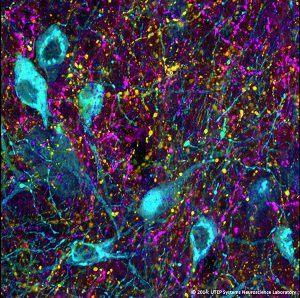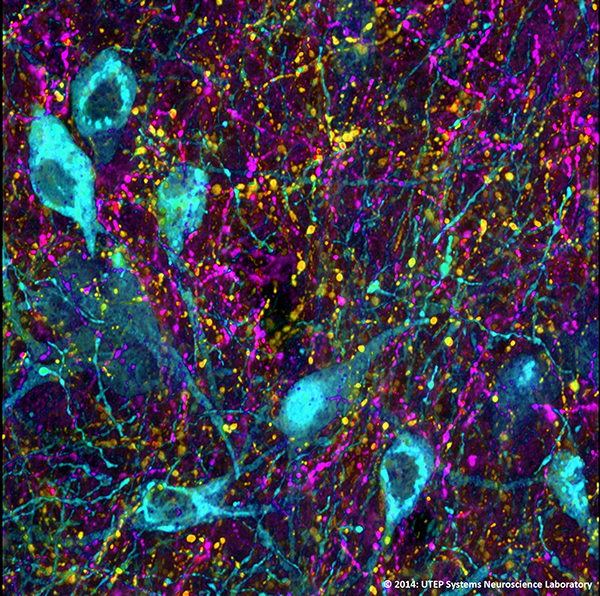By Laura L. Acosta
UTEP News Service
Editor’s note: This is the third story in a series highlighting a few of the interdisciplinary research projects at UTEP making an impact in the community, across the region and around the globe.
Among the scores of rare works neuroscientist Arshad M. Khan, Ph.D., has collected during his 20 years of research is an original German-language monograph from 1910 that features detailed hand drawings of the human hypothalamus by researcher Edward F. Malone, one of the earliest scientists to map this structure in the brain.

“These are individual nerve cells,” said Khan, an assistant professor in the Department of Biological Sciences at The University of Texas at El Paso, as he pointed to a drawing from Malone’s study. “This is a section of the human brain and you can see that these are the individual cells (Malone) drew when he was looking at (the hypothalamus) under a microscope.”
Khan has studied the hypothalamus — the almond-sized region at the base of the brain that helps control a multitude of bodily functions, such as body temperature, hunger, blood pressure and hormone levels — since he was an undergraduate student at the University of California, Riverside. Khan has the distinction of being the first student to graduate from the UC Riverside’s neuroscience Ph.D. program.
Today, Khan is the director of the Systems Neuroscience Laboratory at UTEP where he maps the circuits in the hypothalamus that control eating behavior and help regulate body weight. His goal is to create a detailed atlas of the cells involved in appetite control and to use these maps to ultimately find druggable targets and therapies for obesity, diabetes and eating disorders.
“The hypothalamus has been known since as early as the 1940s to be involved in the control of food intake,” Khan said. “We now know that the hypothalamus contains circuits that not only control appetite, but also circuits that sense changes in our diet and in our nutritional makeup.”
Khan has joined efforts with Sudip Bajpeyi, Ph.D., assistant professor of kinesiology and director of the Skeletal Muscle Metabolism Laboratory in the College of Health Sciences, and Eric MacDonald, Ph.D., associate director of the W. M. Keck Center for 3D Innovation in the College of Engineering, to start mapping the hypothalamus.
Assisting in this effort is one of the world’s leading experts on hypothalamic function Luis de Lecea, Ph.D., associate professor of psychiatry and behavioral sciences at Stanford University. The researchers will be mapping the hypothalamus with the help of a new cutting-edge technique called CLARITY, which is a method where a series of chemical treatments remove the tissue’s lipid content, while leaving most of the original proteins and nucleic acids in place. Proteins are then labeled with fluorescent tags, which produce detailed pictures of the underlying cellular architecture of the brain.
“Nutrient sensing is an important aspect of (Khan’s) research,” explained Robert Kirken, Ph.D., dean of the College of Science. “He is interested in those signals that tell the brain that we need to eat, or not eat. These signals can mean life or death for diabetics if not monitored properly. The question is how does the brain sense when we have the right level of nutrients in our blood and can we know when to intervene? One place to begin is to map the many types of cells, in three-dimensional space, so that we can better understand this very complex and interconnected highway system that relays these signals in our brain and regulates the critical biological response.”
Khan’s collaboration with Bajpeyi and MacDonald stems from President Barack Obama’s BRAIN Initiative (which stands for Brain Research through Advancing Innovative Neurotechnologies), a bold new research effort announced last year that is expected to revolutionize the understanding of the human mind and help researchers find new ways to treat, cure and prevent brain disorders, such as Alzheimer’s disease, epilepsy and traumatic brain injury.
“The BRAIN initiative is a very significant project as it sends a strong message to scientists, clinicians and family members of loved ones afflicted with a brain disease that we need to find answers and cures,” Kirken said. “With worldwide estimates as high as a billion people suffering from some type of a brain disease or disorder, it is a global problem. To develop these new therapies requires substantial and sustained funding in order to better treat, monitor and cure these conditions.”
In March, Khan and his co-investigators Bajpeyi and MacDonald received a $20,000 Grand Challenges Award from the Office of Research and Sponsored Projects (ORSP) at UTEP to initiate their research.
The Grand Challenges Award aims to provide seed money to better position interdisciplinary research teams on campus in their readiness and effectiveness in responding to a number of external funding mechanisms on President Obama’s 21st Century Grand Challenges — ambitious goals on a national or global scale, such as the BRAIN Initiative — that capture the imagination and demand advances in innovation and breakthroughs in science and technology.
The researchers have started to use the seed money to begin a CLARITY setup in Khan’s UTEP Systems Neuroscience Laboratory, which is housed in the Bioscience Research Building. The team plans to leverage their initial research findings to apply for larger grants through the BRAIN Initiative’s funding agencies, including the Defense Advanced Research Projects Agency, the National Institutes of Health and the National Science Foundation.
MacDonald, an associate professor of electrical and computer engineering, will help develop some of the technology needed for the CLARITY setup in the Keck Center and will supervise a UTEP engineering undergraduate student. The student will assist with the project and be financially supported with a stipend from the seed money.
Bajpeyi, whose research interests include exercise science and energy metabolism, will focus on the peripheral nervous system, particularly the neuromuscular junction, which connects the nervous system to the muscular system.
People with metabolic disorders like obesity and diabetes often experience serious health problems at the level of the neuromuscular junction, such as peripheral nervous system neuropathies and nerve-muscle dysfunction.
In addition to hypothalamic tissue, the researchers will use CLARITY to visualize the neuromuscular junction, Khan explained. Another undergraduate student funded by the project also will assist Bajpeyi on his portion of the project.
The BRAIN Initiative has sparked wider interest in neuroscience research, from mapping the brain to investigating mental illness.
“To map and understand the functions of the human brain in its entirety is a very tall order,” Khan said. “It’s something that will take generations of scientists to do. President Obama’s BRAIN Initiative is similar to President John F. Kennedy’s moon challenge about the 1960’s Apollo program, which asked to have a human land on the moon and return safely to Earth by the end of that decade. However, that’s easier to do than map the brain, which will also take much longer to accomplish.”
